To strum the heartstrings with "How Deep Is Your Love," you'll need standard chords like D, Gmaj7, and F#m7. Grab an acoustic or electric guitar and get tuned up. Focus on smooth shifts using a down down up strumming pattern. Fingerpicking can add depth, so try using your thumb for bass notes. Vary your vocal intensity to capture the song's emotion. Stick around to explore techniques that'll enhance your overall performance and connection with the music.
Key Takeaways
- "How Deep Is Your Love" by the Bee Gees features accessible chord progressions like D, G major seven, and F sharp minor seven.
- Essential equipment includes a guitar, tuner, metronome, pick, and strap for better playing comfort and technique.
- The song's verses use a specific down-up strumming pattern, enhancing the smoothness of the performance.
- Focus on vocal dynamics and seamless chord shifts to convey the song's emotional depth effectively.
- Regular practice with a metronome and isolating chord transitions can improve timing and muscle memory for a fluid performance.
Overview of "How Deep Is Your Love"

"How Deep Is Your Love" stands out as a timeless classic that captures the essence of romantic connection. The Bee Gees created a song that resonates with many, thanks to its smooth vocal harmonies and enchanting atmosphere.
If you're looking to play this love anthem, you'll find that the standard chord progressions make it accessible for both amateur and professional musicians. Key chords like D, G major seven, and F sharp minor seven form the backbone of the track, with specific strumming patterns adding depth to your performance.
Since its release in the late 1970s, the song has enjoyed immense chart success and remains a favorite across various genres. Immerse yourself in the world of "How Deep Is Your Love," and let your heartstrings strum along.
Essential Equipment for Learning
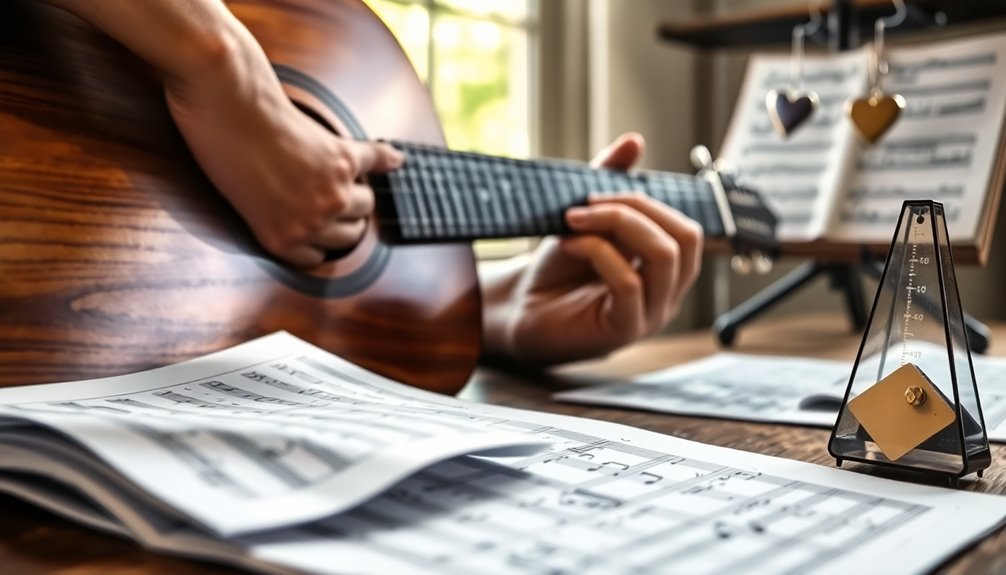
To get started with "How Deep Is Your Love," you need a guitar in standard tuning and a capo on the first fret for the right pitch.
Having the right accessories will make your practice sessions smoother and more enjoyable.
Let's explore what you'll need to set yourself up for success.
Required Guitar Accessories
When diving into learning guitar, having the right accessories can make a significant difference in your progress and enjoyment. Essential items include a standard acoustic or electric guitar, which is your primary tool for playing "How Deep Is Your Love." A guitar tuner guarantees your instrument is perfectly tuned, and a metronome helps maintain a consistent strumming tempo. Using a guitar pick can enhance your strumming technique, providing clearer sound and smoother shifts. Finally, a comfortable guitar strap supports good posture during longer sessions.
| Accessory | Purpose | Recommendations |
|---|---|---|
| Guitar (acoustic/electric) | Primary instrument for playing | Standard tuning with capo |
| Guitar tuner | Guarantees perfect tuning | Clip-on or app-based |
| Metronome | Maintains consistent tempo | Digital or mechanical |
| Guitar pick | Enhances strumming technique | Vary thickness for preference |
| Guitar strap | Supports posture during play | Adjustable for comfort |
Tuning and Capo Placement
Before you start playing "How Deep Is Your Love," it's important to guarantee your guitar is in standard tuning (E A D G B e).
Once that's done, place a capo on the first fret. This will help you achieve the correct key and make chord shifts smoother.
Using a capo not only simplifies your playing but also opens up a wider range of chords, which is great for beginners.
Just make sure the capo is snugly positioned just behind the first fret to prevent any buzzing or muted notes.
Feel free to experiment with the capo on other frets too; you might discover different tonal qualities and voicings that enhance your rendition of the song.
Happy strumming!
Chord Progressions and Strumming Patterns
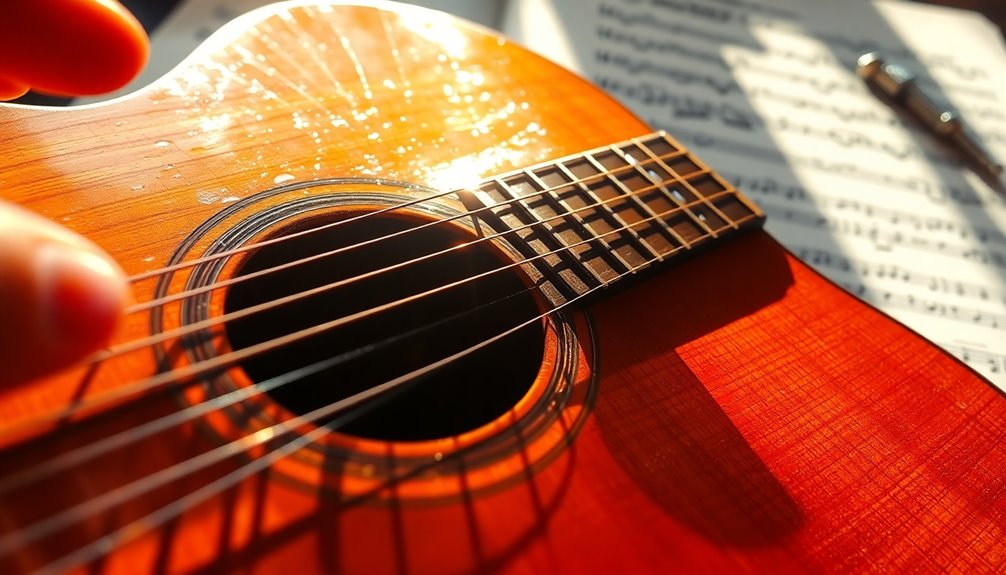
Chord progressions and strumming patterns play an essential role in shaping the emotional landscape of a song, and "How Deep Is Your Love" exemplifies this beautifully.
Starting with a D chord, shifting to D major seven, and moving through G major seven builds a rich harmonic structure that captivates listeners.
In the verses, you'll notice a down down up down down up strumming pattern, while the chorus sticks to a consistent rhythm for stability.
During the pre-chorus, full bar strumming on G major seven and F sharp minor seven creates smooth shifts.
Additionally, incorporating techniques like G slash A, using the middle four strings, enhances the song's harmonic depth, making it a true romantic classic.
Techniques for Fingerpicking
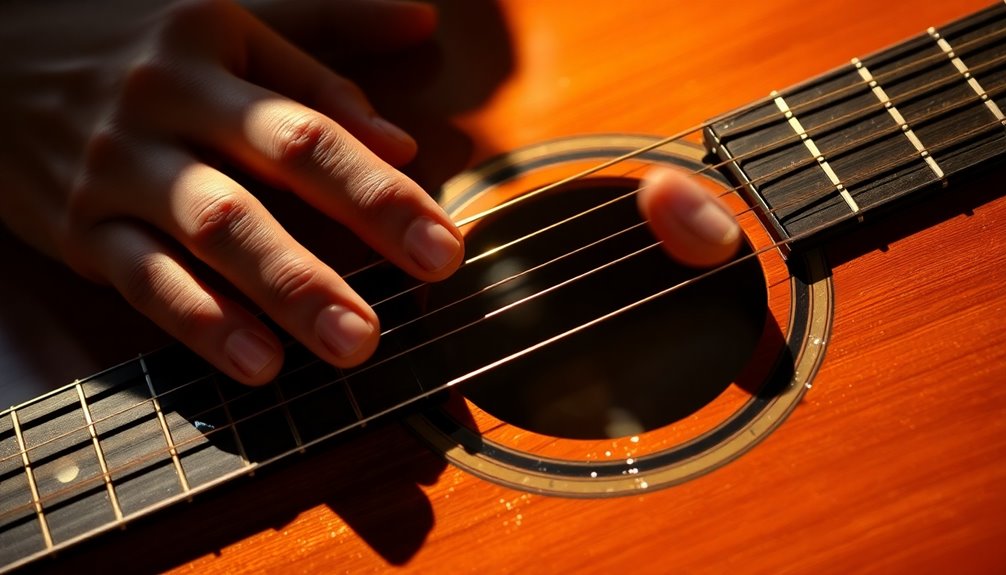
Mastering fingerpicking techniques can greatly enhance your performance of "How Deep Is Your Love." By using your thumb for bass notes and your index, middle, and ring fingers for the melody strings, you'll create a rich, harmonious sound that resonates with the song's emotional depth.
A typical picking pattern follows the rhythm of "one and two and three and four and," with pinching the bass note on the one beat and adding a slap on the two for a percussive touch.
During the verse, adapt your picking pattern with two chords per bar for dynamic rhythm. In the pre-chorus, keep a consistent pattern across all chords for smooth shifts.
Practicing with a metronome will sharpen your timing and accuracy.
Breaks and Song Structure

Understanding the breaks and song structure in "How Deep Is Your Love" is essential for delivering an engaging performance. The song follows a classic format, starting with an intro, then moving through verses, a pre-chorus, and a chorus.
Notice how the break shifts smoothly from the D chord to F sharp minor seven, followed by G slash A for two bars. This creates a seamless segue between sections. The first chorus comes right after the pre-chorus, maintaining a consistent strumming pattern that enhances lyrical flow.
Each verse features unique chord progressions, emphasizing the romantic theme and allowing for dynamic strumming variations. Practicing through to the fourth chorus helps you master the complete structure without adding unnecessary breaks.
Mastering the Verse and Pre-Chorus

To truly capture the essence of "How Deep Is Your Love," focus on the verse and pre-chorus sections, where the emotional depth of the song shines.
Start with a D chord, shifting smoothly to F sharp minor seven, E minor seven, and B7. Stick to the strumming pattern of "down down up down down up" to maintain your rhythm.
In the pre-chorus, begin with G major seven and F sharp minor seven, then switch to E minor seven and C9, keeping your strumming even.
Notice how the second line repeats F sharp minor seven and G slash A, reinforcing the melody. Keep a steady "one and two and three and four" count to guarantee a seamless and expressive performance.
Expressive Chorus Techniques
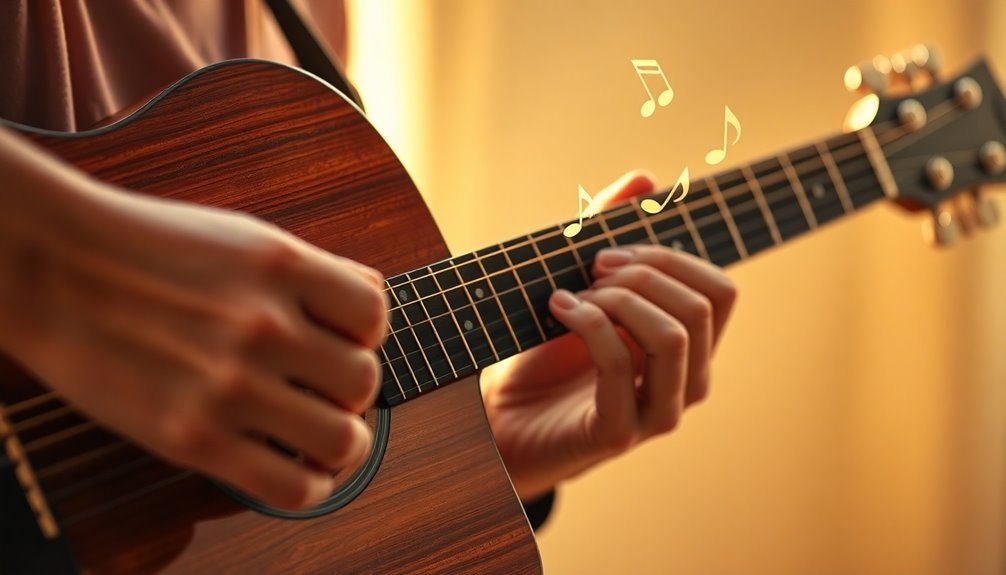
As you immerse yourself in the chorus of "How Deep Is Your Love," notice how the chord progression elevates the song's emotional impact. Starting with D and moving to D major seven, the shift to G major seven and G minor six deepens the lyrical sentiment.
Each line maintains a consistent strumming pattern, making it accessible for beginners. The introduction of A minor slash C and B7 creates a dynamic change, enriching the harmonic texture.
Emphasizing rhythm is vital; it captures the romance and makes the melody memorable. To master the shifts, practice the chorus in sections, paying special attention to the switch from E minor to G minor six for a smooth performance. Additionally, the emotional resonance of music can be influenced by astrological compatibility, enhancing the connection between the performer and the audience.
Playthroughs for Different Styles
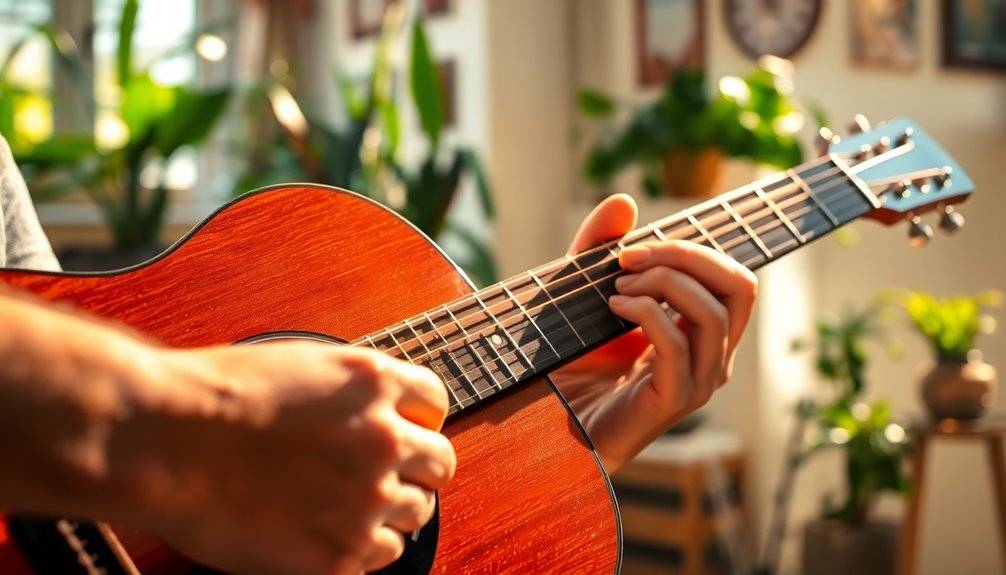
Building on the expressive techniques explored in the chorus, playthroughs for "How Deep Is Your Love" offer diverse ways to engage with the song. You can choose between an easy strum version or a finger-picked approach, allowing flexibility in your playing style. For beginners, a simple strumming pattern like down down up up down up works well, while advanced players can plunge into intricate finger-picking techniques.
Here's a quick overview of the options:
| Style | Pattern | Chords |
|---|---|---|
| Easy Strum | Down down up up down up | D, Gmaj7, B7 |
| Finger-Picking | Intricate patterns | D, Gmaj7, B7 |
| Practice Tips | "One and two and three…" | Consistent timing |
Engage with these styles for a complete learning experience! Additionally, incorporating various quick breakfast options can help fuel your practice sessions effectively.
Tips for Enhancing Your Performance

To enhance your performance, focus on vocal dynamics and smooth chord shifts.
Practice varying your vocal intensity to match the emotional highs and lows of the song, while also ensuring you can switch between chords seamlessly. This combination won't only elevate your sound but also keep your audience engaged. Additionally, mastering EQ techniques can further refine your mix and help you achieve a professional sound.
Vocal Dynamics Practice
While mastering vocal dynamics can feel challenging, it's essential for enhancing your performance. Here are some tips to help you refine your skills:
- Breath Control: Practice techniques to sustain longer notes, especially during the chorus, ensuring clarity and emotional impact.
- Vocal Intensity: Experiment with starting softly in the verses and building to a fuller sound in the chorus to capture the song's romantic essence.
- Sing with Instrumentals: Regularly sing along with the instrumental track to improve your pitch accuracy and timing, vital for smooth harmonies.
- Record Yourself: Use recordings of your practice sessions to pinpoint areas for improvement in vocal expression and dynamics, making adjustments before going live.
- Explore color accuracy to enhance your vocal performance by ensuring that your emotional expression aligns with the tonal quality of the music.
Chord Transitions Smoothness
Mastering vocal dynamics can greatly enhance your performance, but smooth chord changes are equally important for keeping the flow of your music.
To improve your shifts, practice switching between chords like D, F sharp minor seven, and E minor seven with a metronome. Start slow, then gradually increase the tempo as you gain confidence. Position your fingers on the next chord before you strum the current one to minimize delays.
Use consistent finger patterns, like muting the fifth string when moving from G major seven to G slash A, for fluidity. Incorporate strumming patterns, such as down down up down down up, to create a rhythmic foundation.
Finally, isolate and practice segments like the pre-chorus to build muscle memory for smoother overall performance. Additionally, consider the impact of user privacy protection on how music applications collect data to enhance user experiences.
Frequently Asked Questions
What Is the 1/3/5 Rule for Chords?
The 1/3/5 rule for chords is all about constructing major and minor chords. You take the first (root), third, and fifth notes of a scale to create a major chord.
For instance, in C major, that's C, E, and G. For a minor chord, you lower the third note.
This rule helps you in improvisation and composition, providing a solid foundation for building chords and progressions, enhancing your musical creativity.
How Deep Are Your Love Easy Guitar Chords?
You might think playing "How Deep Is Your Love" is too hard, but it's really not!
Start with the easy chords: D, D major seven, and G major seven. The strumming pattern's simple, too—just down down up down down up.
As you practice, try using a capo on the first fret to make it even easier. You'll feel the emotion in every strum, making it a perfect song to share with someone special.
Which Strings to Strum With Chords?
When you're playing chords, it's crucial to know which strings to strum for clarity. For the D chord, focus on the bottom four strings.
With the D major seven and G major seven, mute the fifth string while strumming those same four for a cleaner tone.
Shifting to the G slash A, strum the middle four strings. Keep your strumming consistent across all chords for a smooth flow in your playing.
What Is the B7 Guitar Chord?
The B7 chord is a dominant seventh chord that adds a rich sound to your playing.
To play it, place your index finger across the second fret of the A string, your middle finger on the D string's second fret, your ring finger on the G string's second fret, and your pinky on the high E string's second fret.
You can also play it as a barre chord for easier changes.
Conclusion
As you immerse yourself in "How Deep Is Your Love," remember that mastering the chords is like tuning an orchestra; each string must resonate in harmony to create a beautiful melody. With practice, you'll not only play the notes but also evoke the emotions that make this song special. So, embrace the journey, refine your techniques, and let your heart guide your strumming. You'll find that every chord can strike a chord with your audience.









